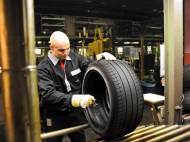First tires out of natural rubber produced in Europe
 There are various attempts to utilize other sources of natural rubber, and we already reported about Ford performing this research. Increased worldwide demand for natural rubber and latex require usage of different sources aside the rubber trees which grow only in suitable climate. There’s also a fact these trees are threatened with a fungal disease potentially capable of destroying rubber tree plantations in South-East Asia.
There are various attempts to utilize other sources of natural rubber, and we already reported about Ford performing this research. Increased worldwide demand for natural rubber and latex require usage of different sources aside the rubber trees which grow only in suitable climate. There’s also a fact these trees are threatened with a fungal disease potentially capable of destroying rubber tree plantations in South-East Asia.
Natural rubber is a unique biopolymer that cannot be substituted by synthetic alternatives in many of its most important applications, like medical products, condoms, footwear or adhesives. Another threat is the increase in the demand for natural rubber in the emerging countries. This circumstance is taking place in a world context in which the supply of natural latex is falling and has led to the doubling of the price in the last two years.
The EU-PEARLS European project was started 4 years ago with a goal to investigate alternative sources of latex and rubber for Europe, and thus reduce the commercial dependence on the natural rubber extracted from rubber tree Hevea brasiliensis. The two most promising alternatives they found are the North-American shrub Parthenium argentatum (guayule) and Taraxacum koksaghyz (Russian dandelion).
Initial studies have shown that both the Russian dandelion and guayule are a good alternative to the rubber tree. Guayule is already being used to produce biomass on a large scale in Spain, yet the rubber from the Russian dandelion seems to be easier to extract. The research has focused on optimizing the development of the growth and speed of growth of the Russian dandelion in order to increase its content of natural rubber available for extraction.
The first tire prototypes obtained from natural latex from Guayule and Russian Dandelion plants have been presented. The production of the first prototypes is a clear indication of the technical performance and economic potential of the rubber extracted. The guayule is regarded as the more promising crop for cultivation in the Mediterranean areas, whereas the Russian dandelion is more suited to the northern and eastern countries of Europe.
Following the cultivation of Guayule and Dandelion plants and the extraction of latex from them, the Dutch tire company Apollo Vredestein, a partner in the EU-PEARLS European project, has recently produced the first prototypes of tires manufactured using natural rubber produced in Europe. The prototypes will undergo exhaustive tests over the coming months before steps are taken towards the production phase.
This success is opening up new market expectations that in a not-too-distant future will be able to break the Asian rubber monopoly. Another advantage of these sources of natural rubber is the fact they don’t cause latex allergy as latex produced from Hevea brasiliensis. One of the downsides is the fact these farms would require far more surface compared to rubber trees, but that problem is solvable with vertically stacked farms of these plants or usage of advanced hydroponics systems.









Leave your response!